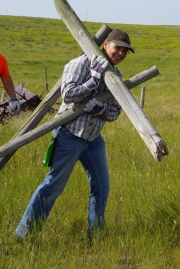Bees and wasps a buzzin'
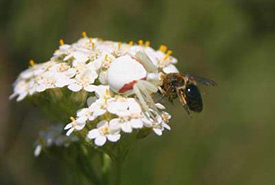
Bees have a good reason to be wary of crab spiders. (Photo by Dr. Diana Bizecki Robson)
Through social media, I learned about the humble bumblebee’s need for drinking water. A need, no doubt, that has arisen as a result of prolonged droughts, loss of wetland habitats and loss of biodiversity. I was asked to incorporate a bee waterer into my yard. I was concerned about enticing a colony of bees to nest in my yard; however, my curiosity won over my fear.
A bee waterer is made up of a shallow dish with platforms — in my case, gravel — so that the bee can drink without getting its feet wet. Success was immediate and although I did not attract the humble bumble, I did attract a wasp species. Several times each day, I spotted a wasp landing and then very carefully walking among the rocks. Between its sips of the water and the heat of the day, I had to refill the shallow dish 3 to 4 times a day. I also learned to check for its presence before refilling the dish, because when water levels got very low, the insect would become hidden from view among the gravel.
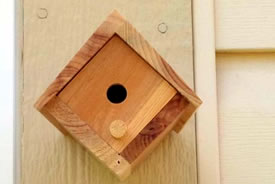
Bee homes come in all shapes and sizes. (Photo by NCC)
As the summer progressed, I wondered if the bee waterer would attract other insects, such as dragonflies, butterflies, house and black flies and mosquitoes. To my surprise, the only insect I saw at the waterer was a wasp.
As severe weather moved in one evening, I spotted a wasp tenaciously clinging to my window screen. Concerned about its ability to withstand the storm, I constructed a bee motel, a home away from home for the insect, from an empty jar and brought it in the house for the evening. The wasp checked out its new digs and then promptly snuggled beneath the petals of the flower in the bee motel. The next morning I checked on it and the only thing I saw was a slight movement of its antennae. I gently shook the contents out of the jar and the wasp landed on top of a flower in a sunny spot outside.
As the sun warmed the wasp, it groggily rolled around the base of the flower’s pistil. Gradually regaining its footing, it carefully groomed the pollen stuck to its abdomen, and then took flight. I was stunned by its rapid increase in energy thanks to the sun’s rays.
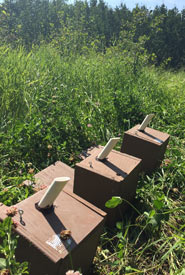
Three bee boxes built by Conservation Volunteers lined up before being nested into the ground. (Photo by NCC)
I wondered what kind of wasp it was. At the Nature Conservancy of Canada’s (NCC’s) spring Conservation Volunteers event at Gambling Lake, I learned from our guest speaker that there are approximately 300 bee species in Alberta and some 500 wasp species in Canada. Unable to identify it down to species, I was, satisfied with that it was simply a wasp.
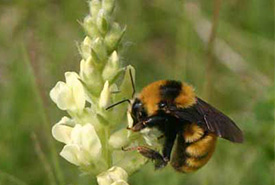
A bumblebee on field locoweed. (Photo by Diana Bizecki Robson)
At the event, we planted nesting boxes filled with nesting fibre for the bumblebees. Nesting boxes are approximately eight to nine inches cubed, with a pipe hole for entry near the bottom. The boxes are planted underground with only the bee's entry side exposed. I was surprised to learn that, on average, most nest boxes could produce as few as 15 bees, including the lone queen, sterile workers, fertile male offspring and fertile future queens. I wondered what impact our volunteer day would produce. As with most science-based projects, only time will tell.
This was not the only Conservation Volunteers event where I encountered a wasp or bee. Nine years ago, I unknowingly stepped on an underground wasp nest. Later that same day, another volunteer called out, “Watch out for the bee’s nest. It’s hanging beside your head.” At a barbed wire-pull this summer, our group also encountered a swarm of wasps whose nest entrance was camouflaged in a crack in the side of a big, old poplar tree. Although this may sound a bit scary, in truth these three encounters make up less than three per cent of the total number of NCC Conservation Volunteers events I have participated in.
So, why help out bees and wasps? Simply put, the dramatic decline in their populations reminds us of the priceless contribution they make to our food production by pollinating plants and crops. Even just a minor contribution on our part in support of their efforts results in positive changes that benefit not just bees and wasps, but all species.

